The Ultimate Guide To Visiting Thailand's Ancient Sukhothai Ruins (Highly Underrated)

We were in Bangkok and we had already obtained our Myanmar visas from the Myanmar embassy. Our plan was to enter Burma via the land border crossing at Mae Sot in Thailand, almost 500km away.
But before crossing over into Burma, we had a little plan up our sleeve. This was now the perfect opportunity for us to explore the Sukhothai Historical Park, by making a pit stop on the way to Mae Sot.
Finally we would get a chance to explore these mystifying ruins and discover what had been left behind of the capital city of the once flourishing and powerful Sukhothai kingdom.
The Location
The modern day city, known as ‘New Sukhothai’ is located about 427km north of Bangkok.
Just 12km west of New Sukhothai is the epicenter of the sprawling ruined city, also known as ‘Old Sukhothai’.
The present day ruins are scattered widely around this epicenter, covering a large area of about 70 sq km, which has now been dubbed the Sukhothai Historical Park.
Sukhothai receives less tourist visitors than its counterpart Ayutthaya due to its more remote location although the ruins here are just as impressive and rewarding to the visitor.

A brief history of Sukhothai
The name Sukhothai derives from Sanskrit terms meaning ‘dawn of happiness’. The Sukhothai era is often sentimentally regarded by some Thais to have been a golden age in Thai history.
Prior to the founding of the Sukhothai Kingdom in 1238, much of modern day Thailand was under the control of the Khmer empire. Sukhothai was one of the empire’s western trade outposts.
In 1239, two brothers drove out the Mon Khmer and one of them became the first king of Sukhothai, ruling as Sri Indraditiya. The founding of the Sukhothai kingdom marked the beginning of the Thai nation, because little was known about Thai kingdoms prior to Sukhothai.
The kingdom reached its zenith of influence and power under the governance of King Ramkhamhaeng, who ruled from 1278 until 1298. During his reign, the Sukothai empire included most of present day Thailand and even extended into parts of Laos and Malaysia. The thai script was said to have been invented during this period also.
After the death of Ramkhamhaeng, the kingdom gradually declined as it lost its hold on many areas that it formerly controlled. In 1398, the armies from the expanding Ayutthaya kingdom forced King Thammaracha II to submit to this new power.
It was therefore a short-lived kingdom, firstly rapidly expanding and then rapidly contracting, before finally becoming integrated with the newly established Ayutthaya empire.
Much of the history of Sukhothai has been revealed through an inscribed stone stele, located on the grounds of its largest temple, Wat Mahathat. The inscription is attributed to King Ramkhamhaeng and is considered to be the first example of the Thai script.
Sukhothai Fact File
- Receives thousands of visitors each year
- UNESCO world heritage site
- 190+ ruins
- Largest temple is Wat Mahathat
- Park covers an area of 70 sq. km
- Park is divided into 5 different zones
The Layout
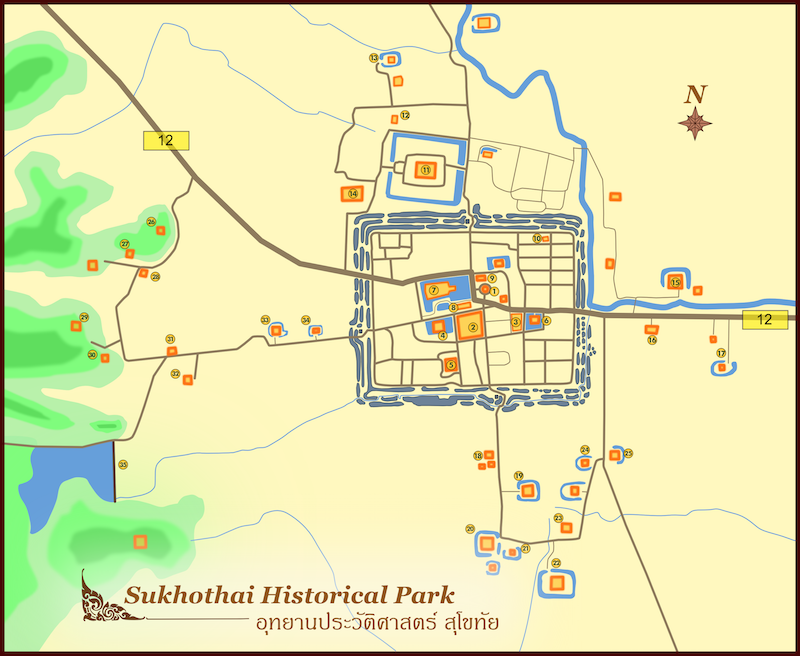
The park is divided into 5 major zones. There is the central zone, northern zone, eastern zone, southern zone and western zone.
The focal point of the historical park is the central zone, which consists of the walled city. The walls extend for 2km from east to west and for 1.6km from north to south, making it slightly rectangular in shape. There is a gate in the centre of each of the four walls.
Inside the walled city are the remains of the royal palace and 11 temples, including the largest and most important temple of Wat Mahathat.
Outside of the walled city boundaries are many more clusters of ruined temples, scattered throughout the other zones. The western zone is interesting in that it consists of forest temple ruins, many of them hidden amongst the trees.
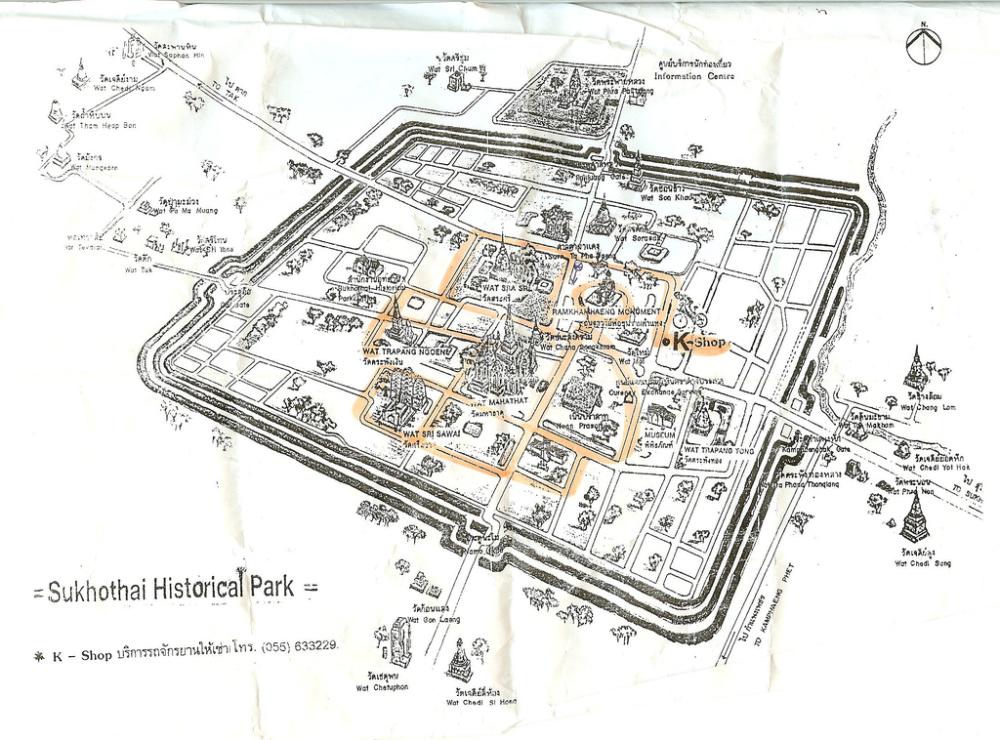
Where to Stay
It’s possible to stay in New Sukhothai and make daily 15 minute trips out to see the ruins by songthaew (shared pick-up truck taxi). Travellers looking for night life or evening entertainment may prefer this option, even though it will be more costly to make daily trips to and from the ruins. There’s also a better range of cheap accommodation options in the new city.
You can also stay in the old city, right next to the historical park. There are plenty of upscale and boutique options here but we also found a few very cheap double rooms for 200 baht.
The advantage in staying here in the old city is that you can immediately begin exploring the ruins at the start of each day. There’s an adequate selection of restaurants to eat at here too, although they were all evidently geared towards foreign tourists and not locals.
We chose to stay in the old city as we don’t really care much for nightlife and we didn't want to waste money on songthaew trips. It suited us perfectly. It's normally fine to just show up and shop around on foot but you can eliminate much of the hassle by pre-booking online.
What to eat
Look out for a special noodle dish called Kuaytiaw Sukhothai. Although this is also available in Bangkok and perhaps other places in Thailand, it originates from here.
Kuaytiaw Sukhothai is a rice-noodle soup, usually combined with slices of roast pork, thinly sliced green beans, ground peanuts and deep-fried pork rind.
The slightly sweet broth it comes with can be served on the side or in the bowl. Just be careful when ordering because the dish will sometimes be served with offal instead of slices of roast pork.
How To Get Around The Ruins

Undoubtedly, the most rewarding and exciting way to explore the ruins is by yourself with a good map.
Paper maps of the ruins are available in many hotels & guesthouses and you can also get a free map if you buy an entrance ticket at one of the ticket booths. We also recommend that you download the maps.me app for navigation (works on android, iOS etc.) and charge up your phone fully for the day.
You can explore the ruins on foot, by rented bicycle or by rented motorcycle. We would highly recommend either the bicycle or motorcycle option as the ruins are quite extensive and you won't get very far on foot in the heat.
You can easily rent a bicycle for 30 baht from one of the small rental businesses opposite the eastern gate and renting a motorcyle may also be a possibility if you ask around.
Entrance fees and how to avoid them
There are ticket booths at the main entrances to all the zones, most of them charging 100 baht for foreigners and 20 baht for Thai people. There are then additional charges for bicycles and motorcyles.
You can see how those entrance fees could really start adding up if you wanted to explore all five of the zones.
The best way to avoid the fees is by using alternative roads and pathways to enter the zones. Avoid the checkpoints like the plague and try to find another way in.
The central zone and western zone entrance fees are easily avoided by using unconventional entrances, while the Northern Zone is a bit more difficult to avoid during the working hours.
The maps.me navigation app for Android & iOS is very helpful for avoiding the ticket checkpoints as it will show you the smaller lanes and backroads that will allow you to bypass them.
Many of the ticket checkpoints are also unmanned after 4 p.m, although you won’t have enough time or light to fully appreciate all of the different sites within the zone if you go so late in the afternoon.
Additional Tips
- Bring 2-3L of water, especially if you're going to be out for hours in the afternoon heat.
- Protect your skin from the intense sun by staying covered or by applying thanakha. Don't use commercial sunscreen products. Most are toxic and harmful.
- Explore the outer zones in the early morning and afternoon. Leave the central zone for the late afternoon and head to Wat Mahathat an hour before the sunset for the incredible atmosphere and amazing photo opportunities.
The 10 must-see temples of Sukhothai
With over 190 ruins scattered over a pretty large area, it’s unlikely that you’re going to have the time and energy to see them all. Unless you’re a temple fanatic, your motivation for seeing more temples will probably have dwindled significantly after 2 full days of exploring the ruins.
Besides, many of the outlying temples are poorly or completely unrestored and although this makes the experience more authentic, it also means that you’re often just looking at what is essentially a pile of rubble. Virtually all the interesting treasures and artifacts have been removed and transferred to the museum.
The most restored and best-maintained temples are the ones inside the walled city. However, there are several other splendid ruins outside the walled city, which are well worth checking out.
We will show you our 10 favourite temples of Sukhothai so that you know where to make for if time or motivation is a limiting factor.
1. Wat Mahathat

Wat Mahathat is the largest, most important and most impressive complex in the park. It’s also the site that's most likely to be flooded with tourists.
The name means ‘temple of the great relic’. The principal chedi (stupa) is shaped like an closed lotus bud and encircled by 8 smaller chedis:

The base is this main chedi is adorned with 168 stuccoed sculptures of Buddhist Disciples posing with their hands clasped together:

The complex also includes viharas (prayer halls). These feature beautiful laterite columns and and often a seated Buddha statue on a platform at one end.

The main vihara (prayer hall) at Wat Mahathat is pretty mindblowing:

Another type of structure found in Wat Mahathat is the ubosot or ordination hall. This is the holiest and most sacred prayer room, where ordinations would have taken place. Here is the ordination hall at Wat Mahathat:

There are also two mandapas (pavilions) in Wat Mahathat, one on either side of the principal Chedi. Each mandapa enshrines an 11-metre tall standing buddha image:
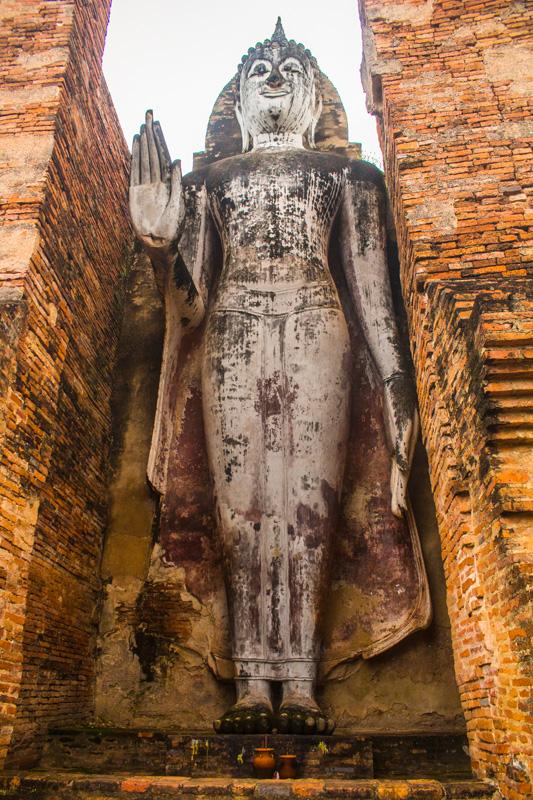
Wat Mahathat also features over 200 subordinate (smaller & less important) chedis and a beautiful surrounding moat filled with (often) blooming red water lilies (nymphaea rubra). You can see the lily-filled moat in the first Wat Mahathat image above.
Oh and we almost forgot to mention, the sunset here is absolutely magical. You really should time your visit to Wat Mahathat to coincide with the sunset:

2. Wat Sa Si
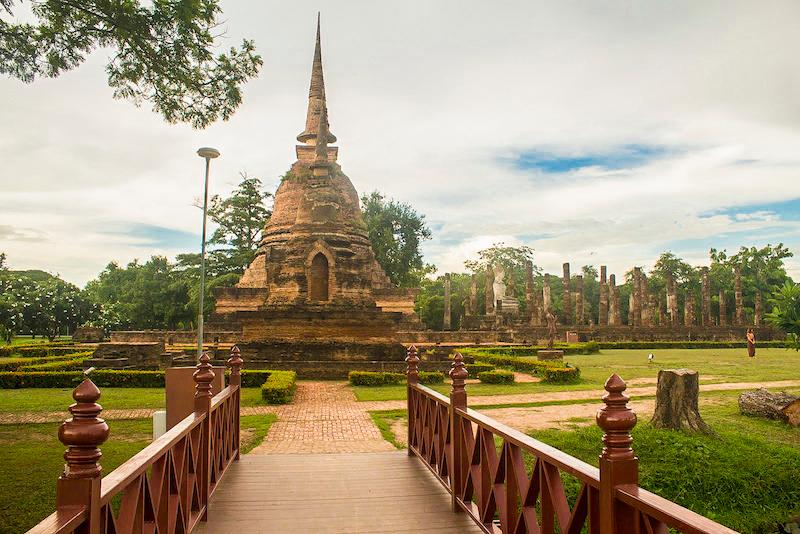
This site is inside the central zone, located to the north-west of Wat Mahathat. The complex is actually on a small island, in the midst of Traphang-Trakuan lake and you have to cross a small wooden bridge to access the compound.
As you enter, you’ll be looking at the smaller chedi on a square base and beyond that is the main Sinhalese style, bell-shaped chedi with its tapering spire. Right to the east of the smaller chedi, you’ll notice the beautiful standing Buddha image in the ‘walking posture’...
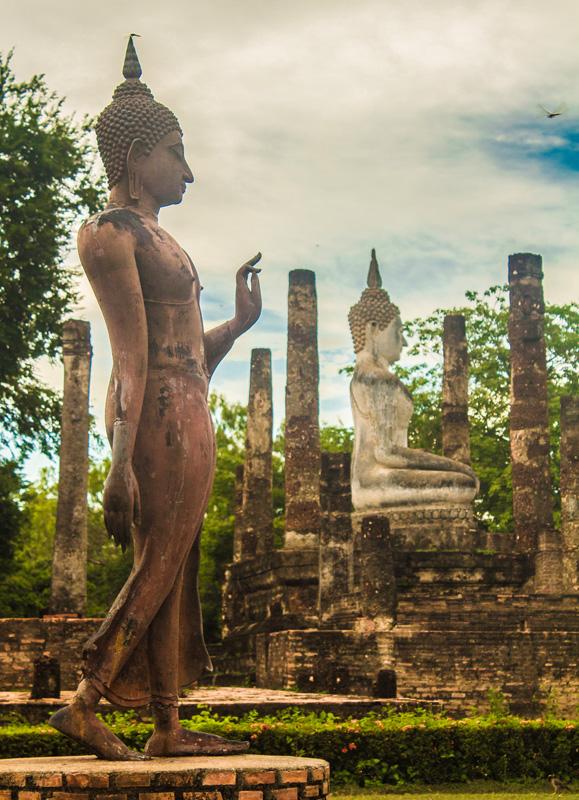
There are also the remains of the vihara, with its laterite columns and an impressive seated Buddha image.

The ubosot (ordination hall) of this complex lies on it’s own separate island to the east, reached by another bridge. It looks very similar to the vihara shown above, with a tall chedi behind it.
3. Wat Tra Phang Ngoen
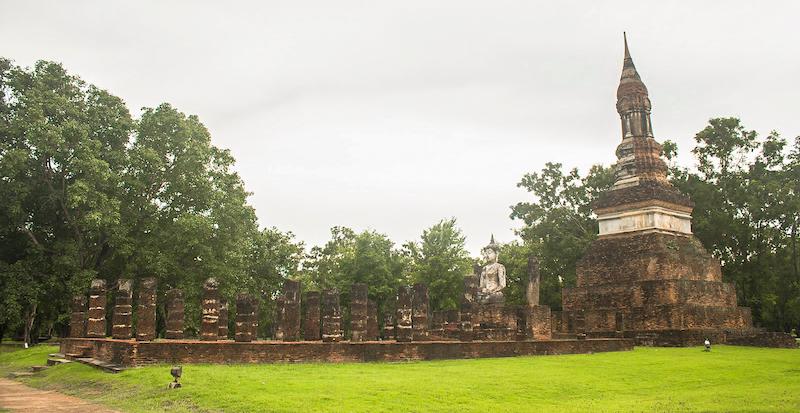
This is another site within the central zone, found to the west of Wat Mahathat. The name here translates to ‘silver lake monastery’.
The monastery features a tall chedi, designed to resemble a closed lotus flower bud. The chedi sits on a tiered square base. Near the top of the chedi, you’ll see there are Sukhothai style Buddha images inside four little niches that face the cardinal directions.
The adjacent vihara features the usual laterite columns and a seated Buddha image in the Bhumiparsha Mudra (Earth witness gesture) at the west end.
.jpg)
The other part of the monastery is the ubosot or ordination hall and in the same fashion as the ubosot at Wat Sa Si, it is situated in the middle of the adjacent artificial lake (silver lake).
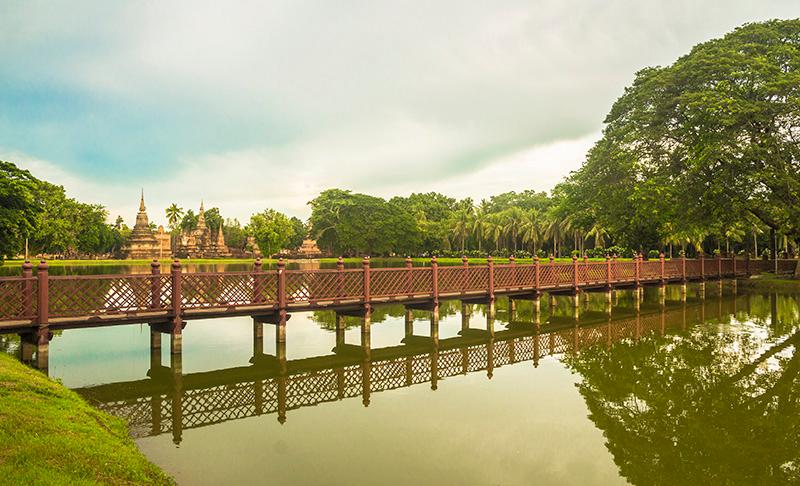
The ordination halls were often deliberately placed in the middle of a water body, to improve their ‘purity’. Unfortunately, little remains of the structure here except the foundations and a few stumps.
4. Wat Si Sawai
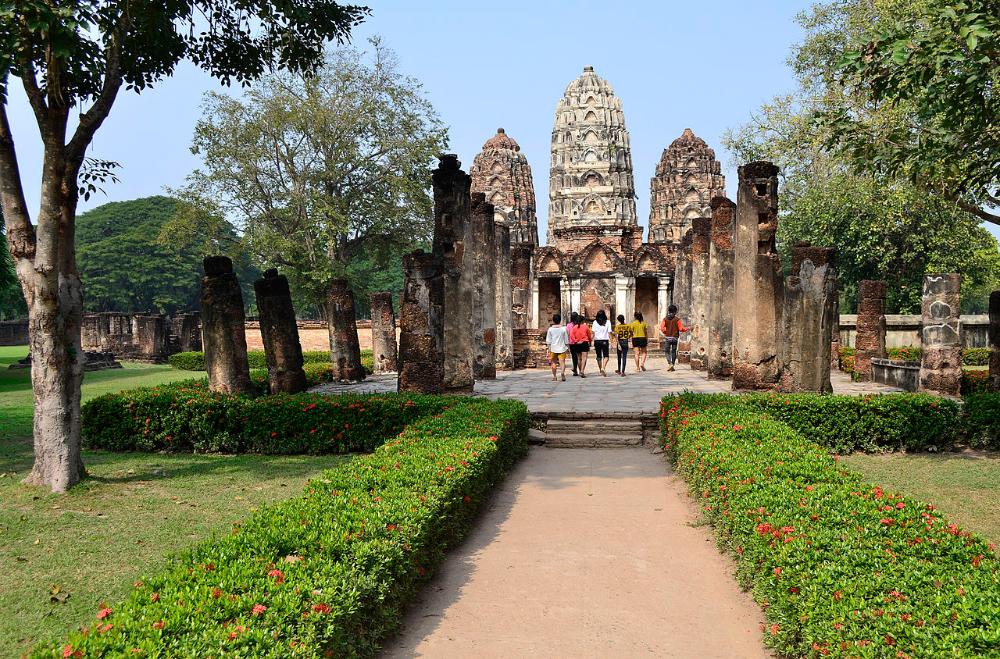
Regrettably, we missed this site, as it was a choice between this or Wat Mahathat for the sunset. Wat Si Sawai is located in the central zone, a few hundred metres south-west of Wat Mahathat.
Like Wat Phra Phai Luang, this site also possesses the Khmer style prangs, except the three prangs here are all wonderfully preserved. The central prang is the tallest at 15 metres.
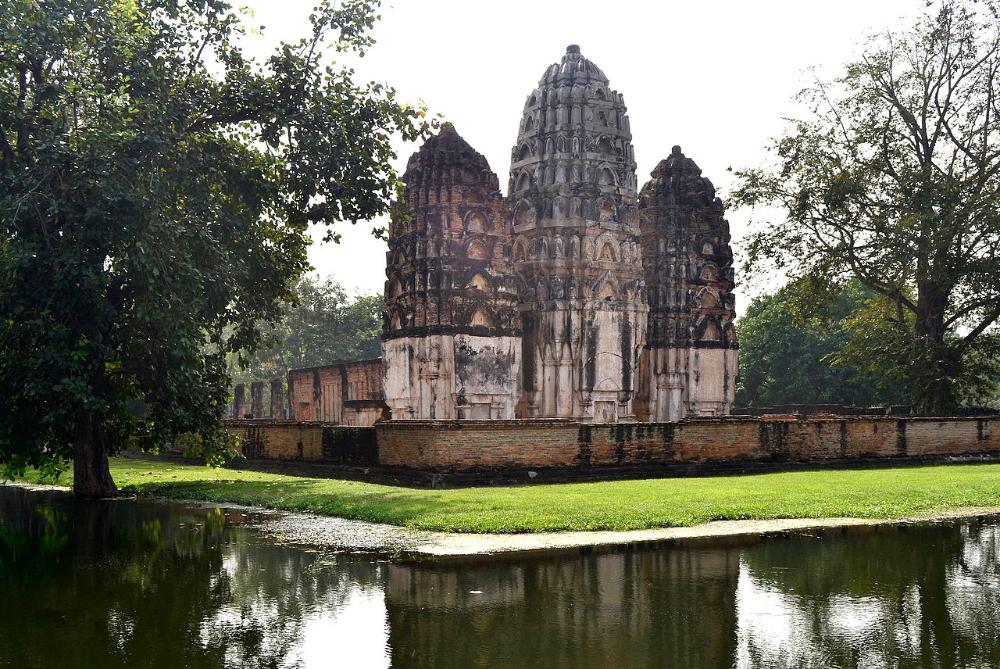
The three prangs actually represent the holy trinity in Hinduism (The three Gods - Shiva, Brahma, Vishnu). The prang towers show an interesting blend of Khmer and Thai artistic influence; the lower parts exhibit sculptures of characters and monsters from hindu mythology and the upper parts feature enshrined buddha images inside niches.
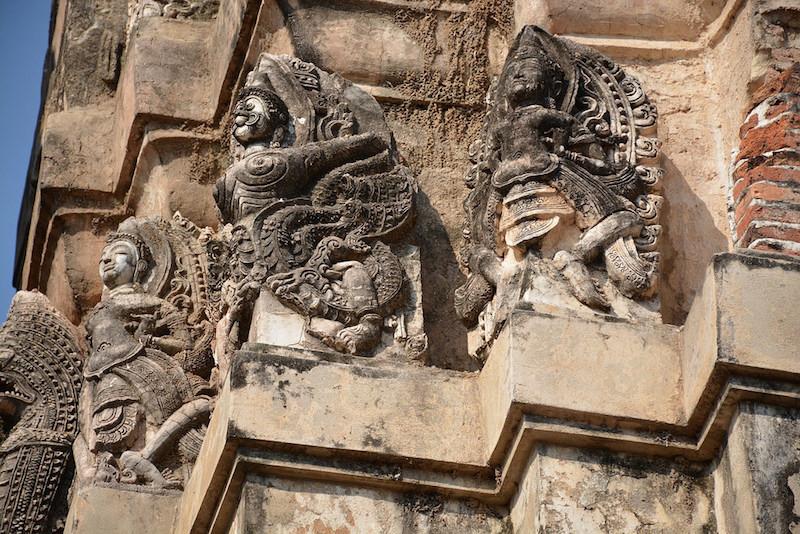
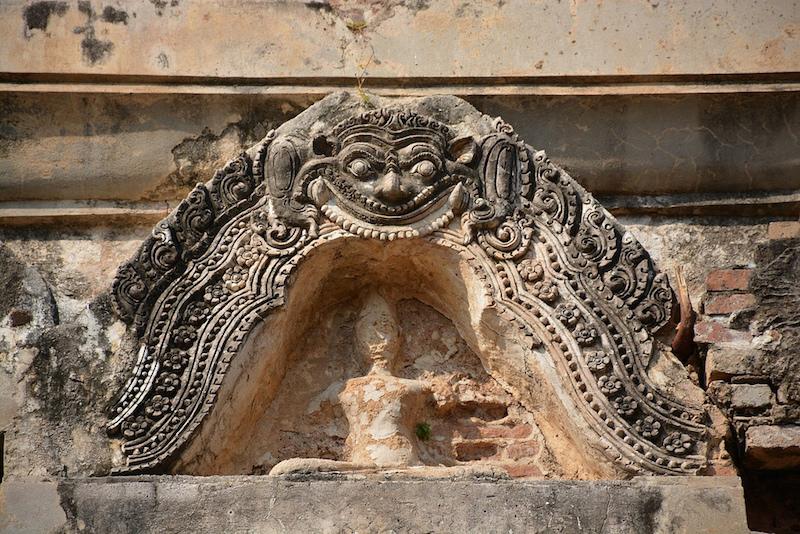
The main viharn (prayer hall) here in front of the central prang is in good condition with the walls still in tact. Outside the walls of the main viharn, only the foundations and pillars of the secondary viharn remain.
The complex also features a moat and a laterite boundary wall.
5. Wat Phra Phai Luang

Wat Phra Phai Luang is one of the most impressive sites in the Northern zone and it was indeed the largest temple in the city surrounds. The complex is surrounded by a double moat, which is fed by a small local river.
The striking thing about this temple is the Khmer style prang (tower) at the west end of the site. There were originally 3 prangs here but the other two have collapsed. The prang entrances face east, with false doors on all the other sides.
.jpg)
At the east end of the complex, you’ll find the remains of a mandapa (pavilion). Four 11-metre tall standing Buddha images face the cardinal directions on the outside of the Mandapa. However, the images no longer stand in their full glory:
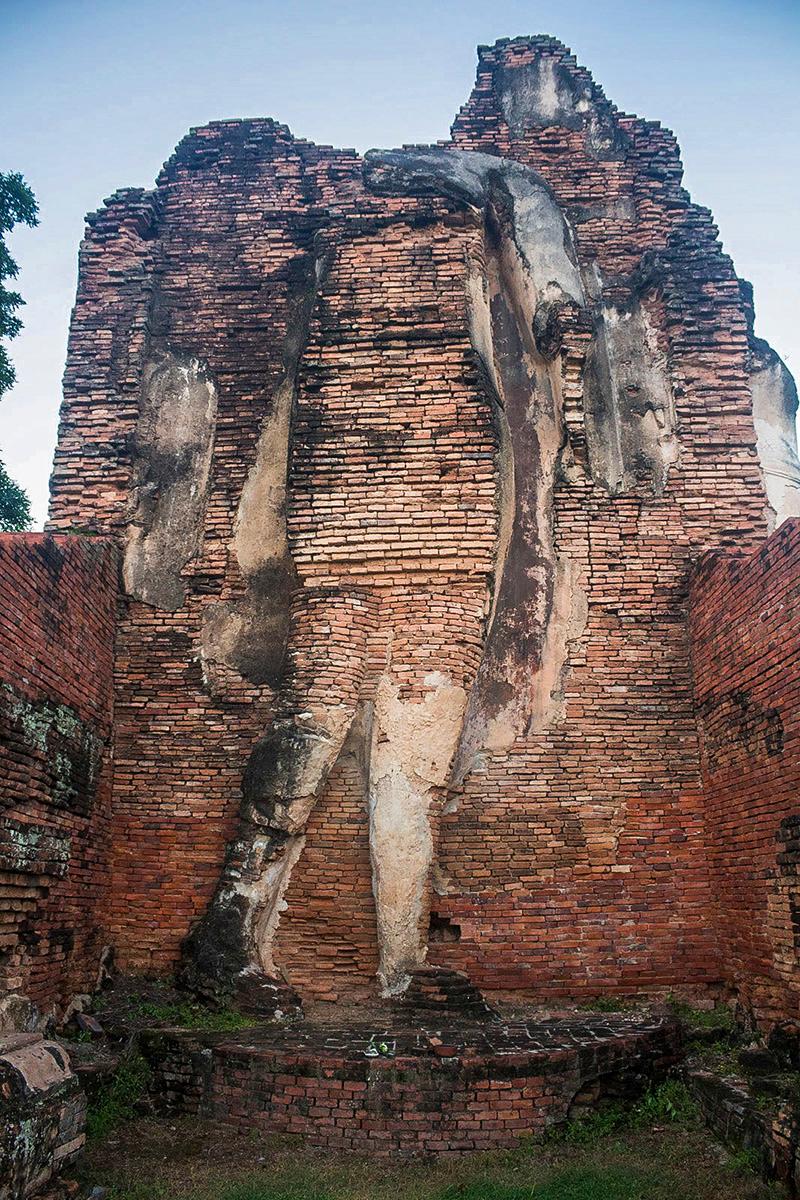
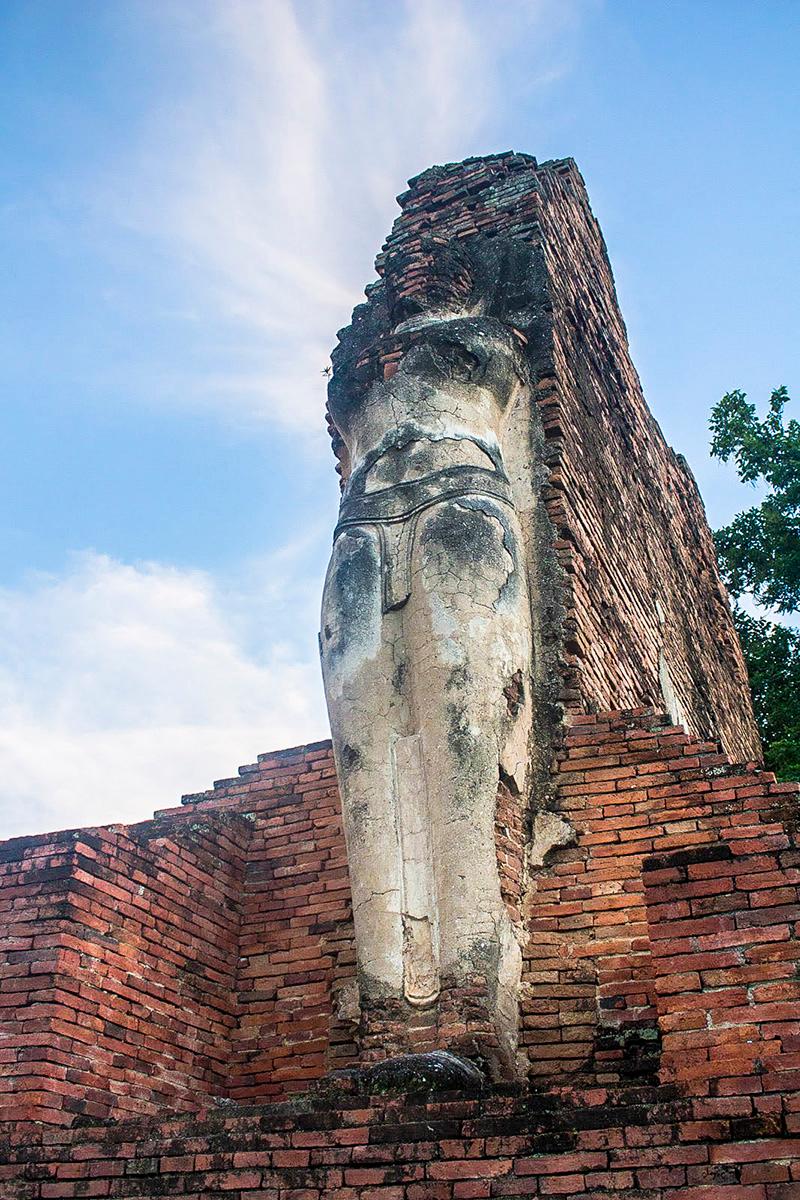
There's also the remains of a large chedi west of the Mandapa, surrounded by several ruined subordinate chedis.

The chedi enshrines numerous small Buddha images, tucked away inside niches. You’ll notice that many of the images are beheaded. This was probably done by night raiders looking to sell the heads on the black market.
6. Wat Si Chum
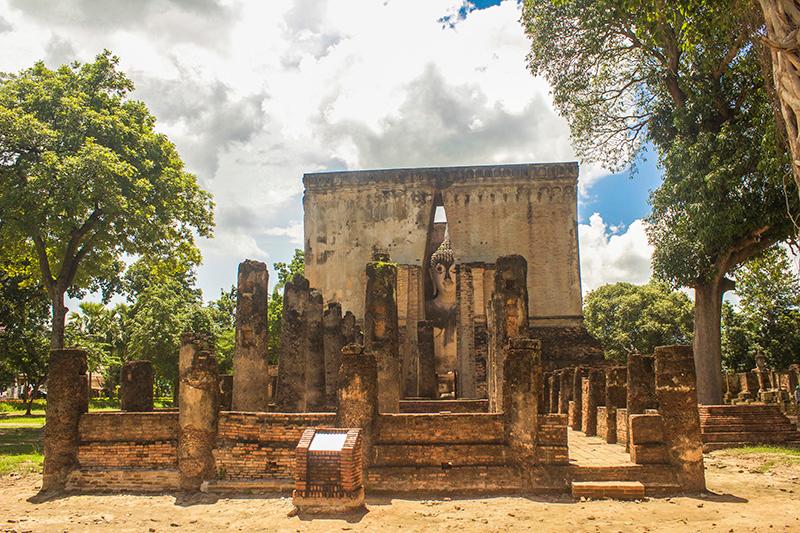
Also in the Northern zone and located close to Wat Phra Phai Luang, this site is surrounded by a moat and most notable for it’s enormous seated Buddha image in the ‘subduing mara’ posture. In this posture, the Buddha is calling the Earth itself to bear witness to his enlightenment.
The image is known as the 'Phra Achana' buddha image and that translates to 'he who is not frightened'. At 11 metres wide and 15 metres high, it's the largest buddha image in Sukhothai:

The image is contained within a large mandapa (pavilion), which has very thick walls (3ft thick) and a very narrow vertical slit opening on the east side. There is a narrow passageway in the south wall of the mandapa, with a staircase which leads to the roof of the mandapa. It's closed to visitors unfortunately.
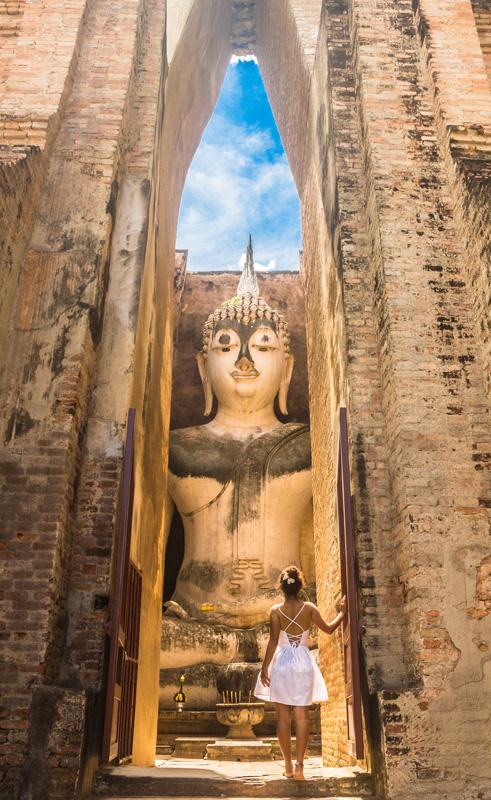
To the north of the Mandapa, there’s another vihara with another well preserved Buddha image inside a much smaller mandapa:

Let's take a closer look at that second buddha image:
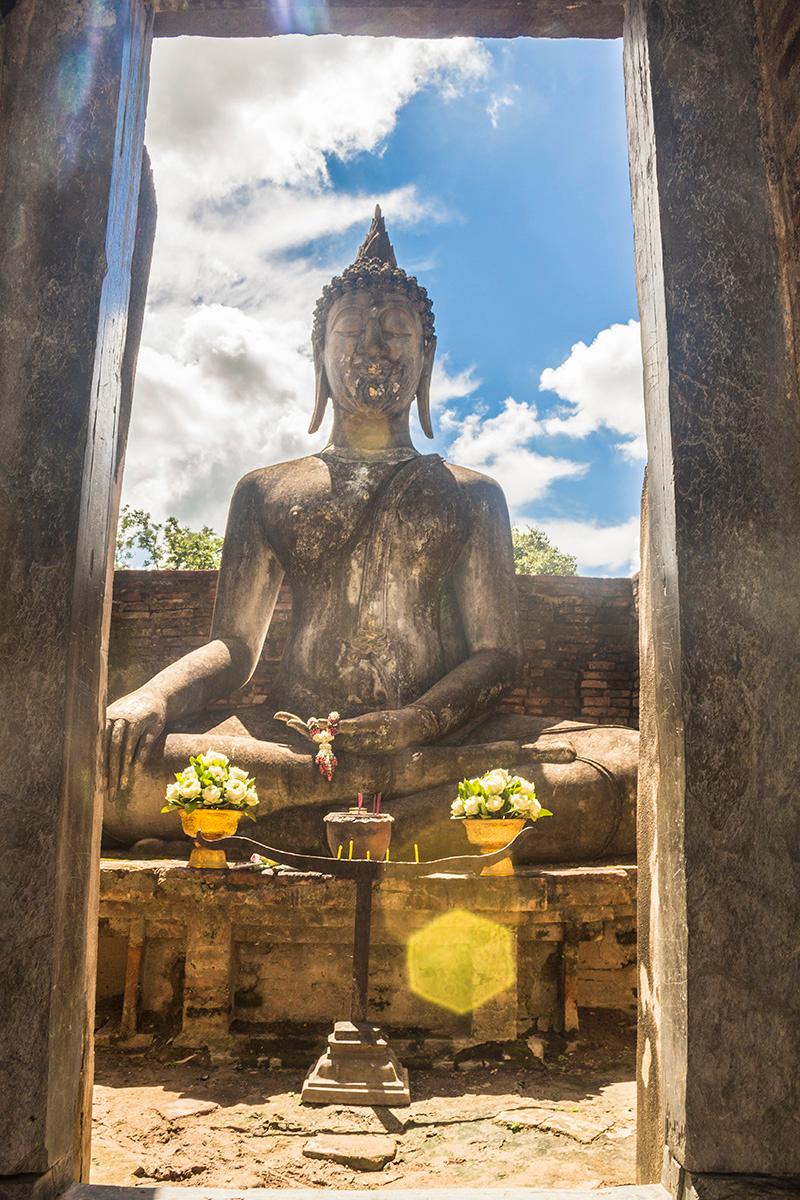
7. Wat Saphan Hin
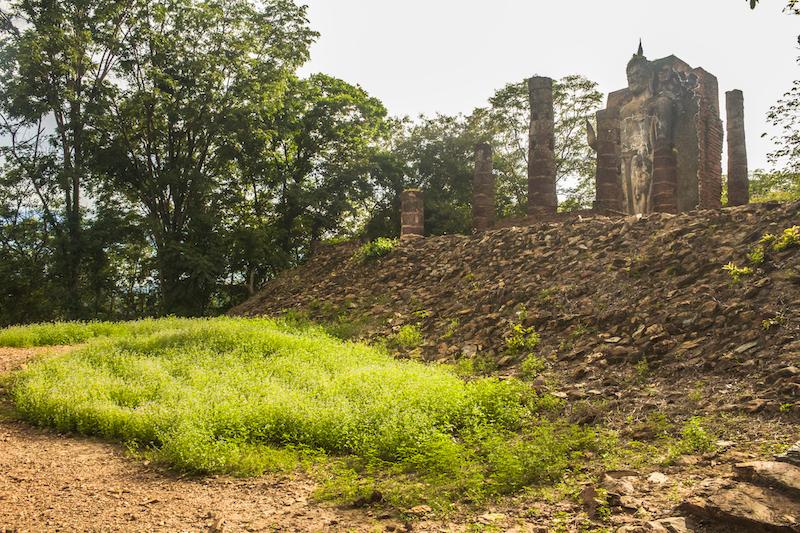
This is the highlight of all the forest ruins in the remote western zone. It’s located on a hilltop, 200 metres above the plains below and that means that you'll have to exert yourself a little to see it.
Because this temple is inside a different zone, there is a 200 baht entry fee and additional fees on top of that if you arrive on a bicycle or motorcycle. You can avoid this fee however if you take a turn off the main road down a small side road, about 1.2 km before reaching the main entrance. This side road also brings you into the western zone.
The name 'Wat Saphan Hin' means ‘Stone Bridge Monastery’, which refers to the dry stone slate causeway that leads all the way from the base up to the monastery at the top of the hill.
After the sweaty climb to the top, you’ll be rewarded with a nice vantage point to view the surrounding plains. Beautiful swathes of blue mistflowers were in bloom here when we were there.
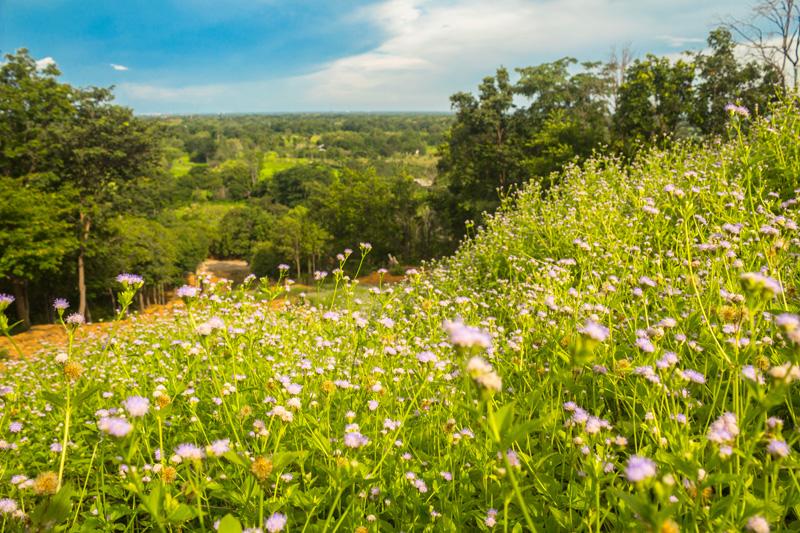
Apart from the view, the other main reason to make the climb is to see the impressive 11-metre tall standing Buddha image up here; it’s one of the ‘Phra Attharot’ Buddha images. There’s also a smaller seated Buddha image at the base:
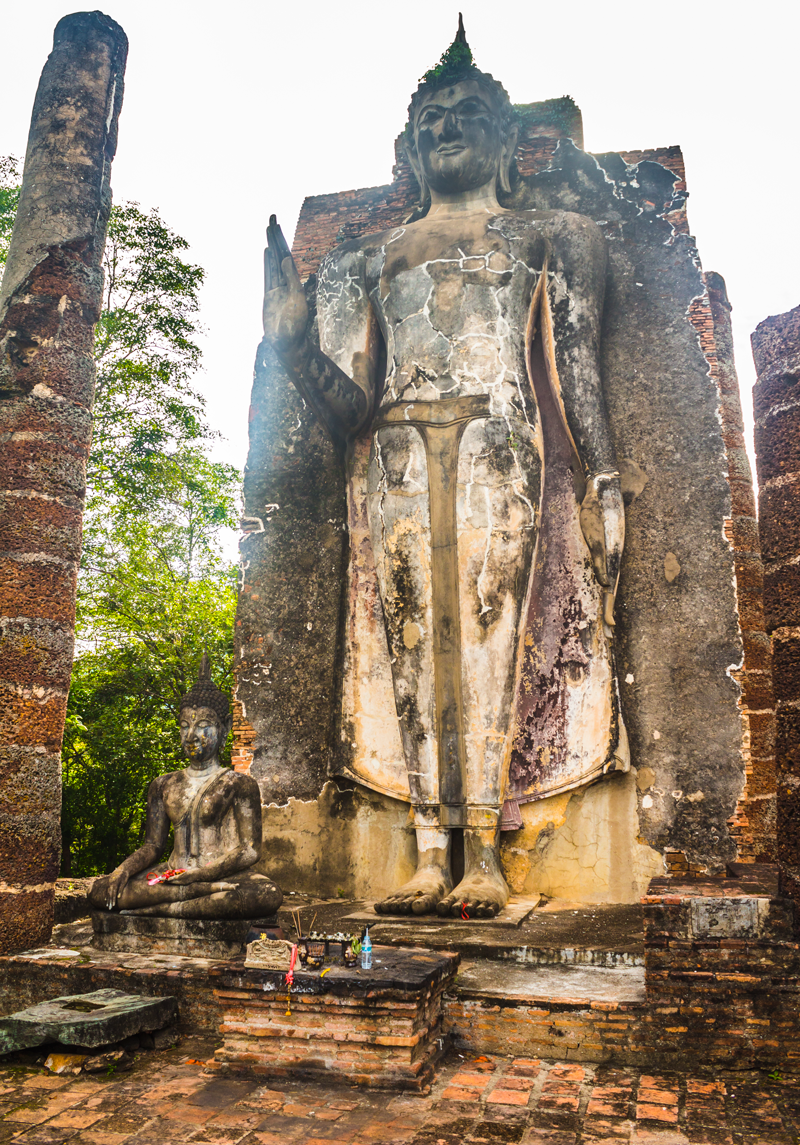
It is said that King Ramkhamhaeng The Great would pay tribute to this temple on each Buddhist Sabbath Day (Uposatha) after being carried to the top of the hill on the back of a white elephant called Ruchakhari.
8. Wat Sorasak
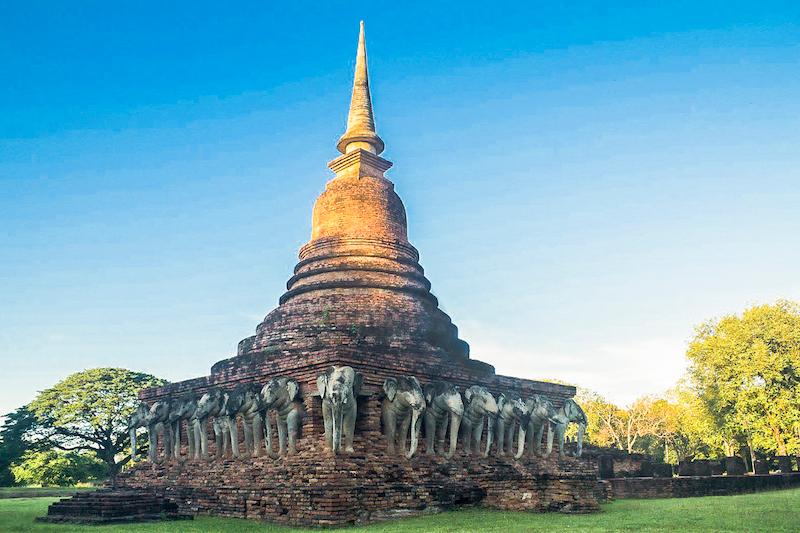
This is a small site in the Northern zone but the 24 elephant statues that surround the main Sukhothai-style chedi are very well preserved. The statues protrude out from their own little niches in the base of the chedi.
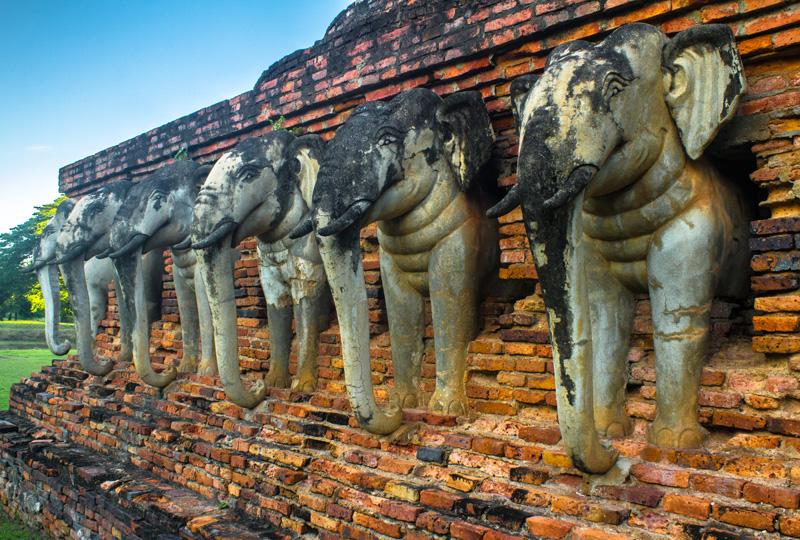
You’ll also notice small raised brick platforms around the chedi. These would have originally held seated Buddha images. The chedi is adjacent to a ruined vihara but only the stumps of the original columns remain.
A stone inscription that was discovered here has dated the site to 1412.
9. Wat Traphang Thong

The name translates to ‘golden lake monastery’. This one is just off the main road, near the eastern entrance to the walled city.
As the name suggests, the monastery is located on a small island in the middle of a lake and you can access the island by crossing a wooden bridge on foot:
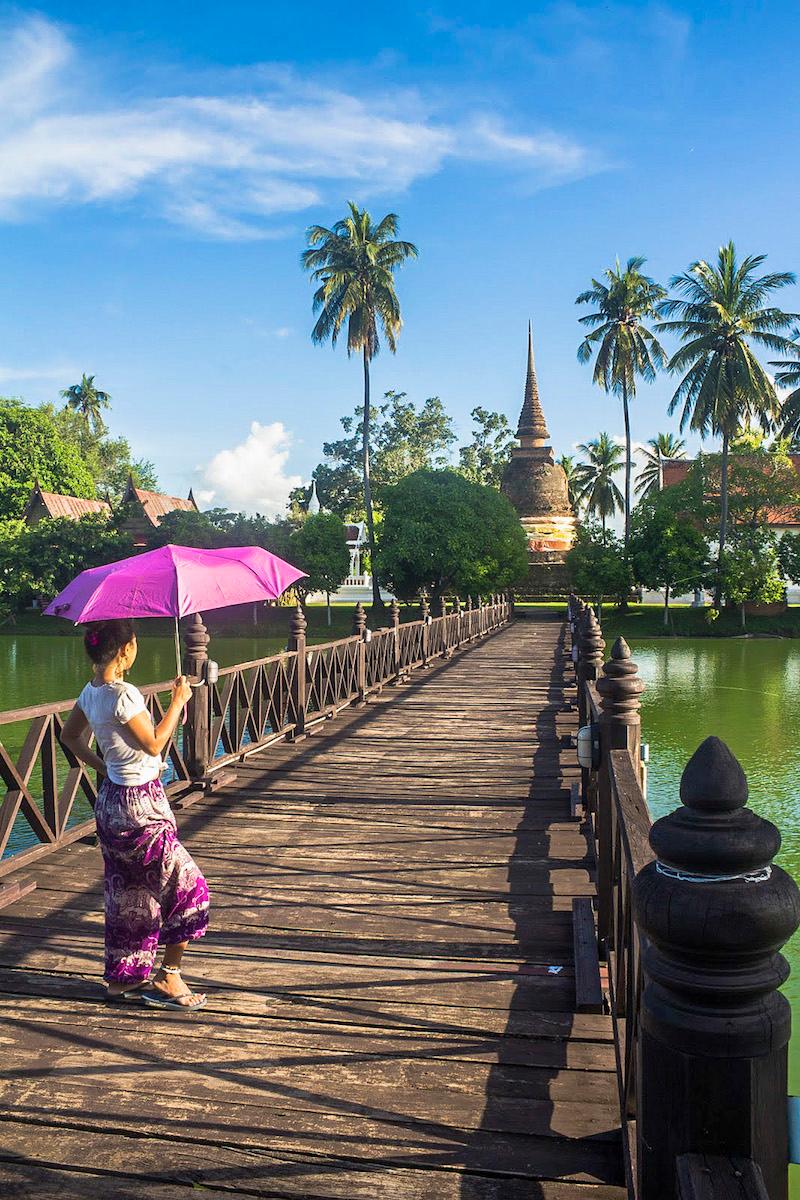
There’s an old brick stupa here in the typical bell-shaped Sukhothai style and a modern ubosot (ordination hall), which was constructed in the 19th century by the governor of Sukhothai. There are two beautiful whitewashed buddha statues at the entrance to the ubosot.

The monastery is also famous for its Buddha footprint, which is housed within a modern mandapa (pavilion). The footprint was crafted in 1359 during the reign of King Li Thai and was formerly housed at a nearby hill called 'Khao Phra Bat Yai,' which translates to 'Big Footprint Hill.'
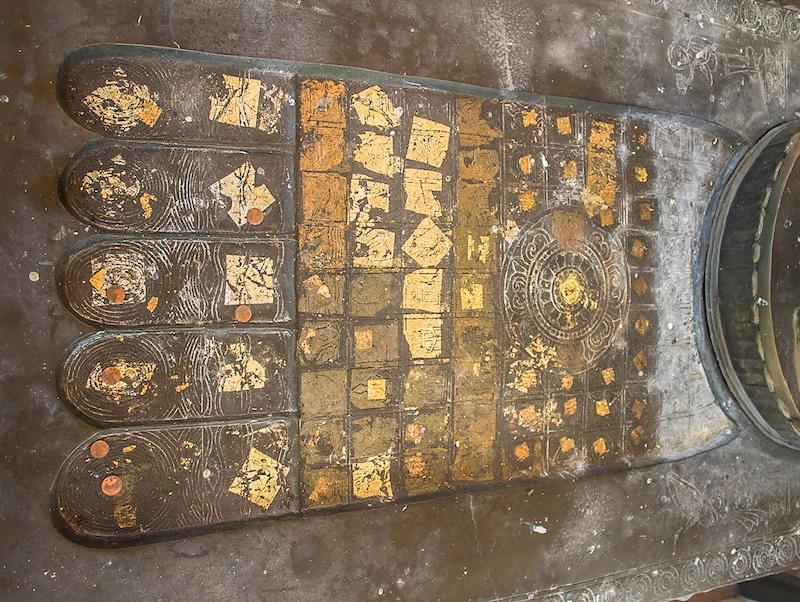
Other things to do in Sukhothai
If you become 'templed out' from seeing too many similar looking ruins, you can also visit the Ramkhamhaeng National Museum. You might also want to check this out before you set out to explore the ruins, to help you better appreciate and understand what you see.
The museum is located just next to the main entrance to the central zone and there is a separate admission fee of 150 baht, not covered by the ticket to the central zone.
Inside the museum you'll be able to take a look at the famous Ramkhamhaeng inscription, believed to be the first Thai script. There are also a number of Sukhothai artefacts, relics and antiques on display here, many of which were recovered from the various ruined monasteries and the surrounding area.
Watch Video:
Recommended Guidebook: Lonely Planet Thailand
JOIN OUR LIST
SUPPORT US
FOLLOW US
ABOUT US
Our names are Eoghan and Jili and we hail from Ireland and India respectively.
We are two ardent shoestring budget adventure travellers and have been travelling throughout Asia continuously for the past few years.
Having accrued such a wealth of stories and knowledge from our extraordinary and transformative journey, our mission is now to share everything we've experienced and all of the lessons we've learned with our readers.
Do make sure to subscribe above in order to receive our free e-mail updates and exclusive travel tips & hints. If you would like to learn more about our story, philosophy and mission, please visit our about page.
Never stop travelling!
FOLLOW US ON FACEBOOK
FOLLOW US ON PINTEREST
-lw-scaled.png.png)


